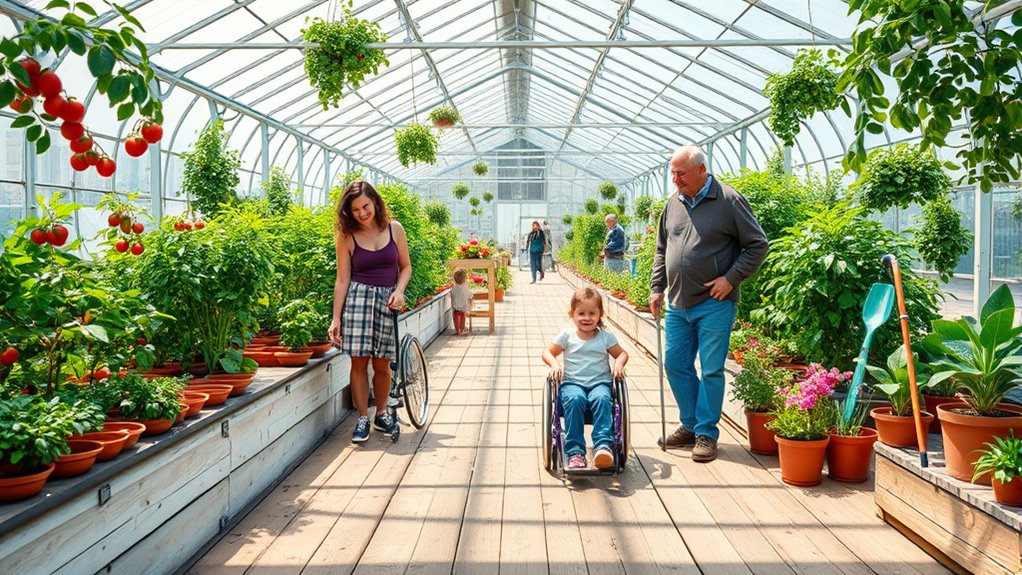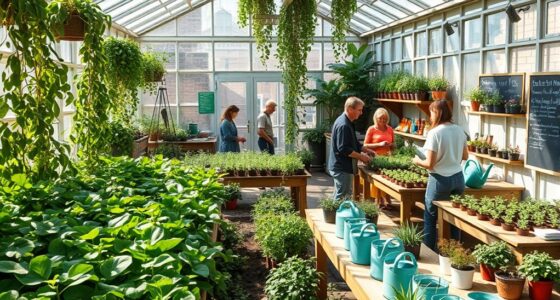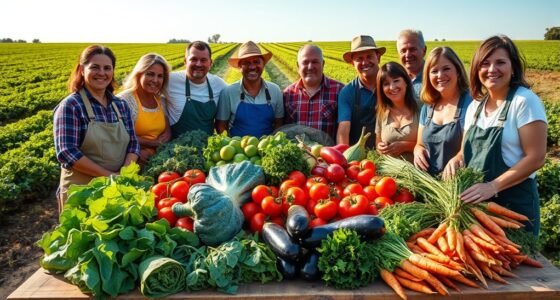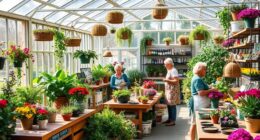Creating an inclusive greenhouse means designing it to be accessible for everyone, regardless of physical ability or experience level. Use wide, slip-resistant pathways, adjustable planting beds, and controls at reachable heights. Incorporate assistive tech like voice commands and tactile labels, along with clear signage. Prioritize renewable energy sources and sustainable features to promote eco-friendliness. By implementing these principles, you’ll foster a welcoming environment that supports participation and community building — discover more ways to make urban farming truly inclusive.
Key Takeaways
- Design pathways and surfaces that are wide, slip-resistant, and free of tripping hazards to ensure safe navigation for all users.
- Incorporate adjustable, tiered, and accessible planting systems like raised beds to accommodate diverse physical abilities.
- Use renewable energy sources and automated climate controls to create a sustainable, stable environment suitable for everyone.
- Implement assistive technologies such as voice commands, tactile labels, and visual cues to enhance accessibility and inclusivity.
- Ensure controls and signage are positioned at accessible heights and are easy to operate, promoting active participation for all users.

Inclusive greenhouse design guarantees that everyone, regardless of physical ability or experience level, can participate in and benefit from gardening. When you create a space that considers diverse needs, you open the door for more people to enjoy urban farming’s advantages. One way to achieve this is by integrating vertical farming techniques. Vertical farming maximizes space by stacking plants upward, making it easier for those who may have difficulty bending or reaching low to tend to crops. The use of tiered planting systems allows gardeners with mobility challenges to access plants comfortably, without compromising productivity. Incorporating adjustable planting surfaces, such as raised beds or modular containers, further enhances accessibility, ensuring that individuals of varying heights or physical conditions can participate equally.
Designing inclusive greenhouses with vertical farming and adjustable surfaces ensures accessible, engaging urban gardening for all abilities.
Harnessing renewable energy sources also plays a vital role in inclusive greenhouse design. Solar panels, wind turbines, or other renewable solutions reduce the greenhouse’s carbon footprint and create a more sustainable environment. By implementing renewable energy, you can maintain climate control systems efficiently, ensuring a consistent environment for all users regardless of external weather conditions. This stability benefits those with sensory sensitivities or health conditions that require specific temperature and humidity levels. Additionally, renewable energy systems often include user-friendly features like automated watering and climate controls, simplifying operations for less experienced gardeners and those with physical limitations.
Designing with accessibility in mind extends beyond structural elements. Pathways should be wide and smooth, free of tripping hazards, and made from slip-resistant materials. Controls for irrigation, lighting, and ventilation should be at accessible heights and operable with minimal strength or dexterity. Clear signage with large, high-contrast text and visual cues helps users with visual impairments navigate and understand the space. You should also consider incorporating assistive technologies, such as voice-controlled systems or tactile labels, to make the greenhouse more inclusive. These features empower everyone to participate actively, regardless of their physical or sensory abilities. Fostering inclusive design principles is essential for creating a truly accessible environment that accommodates a diverse range of users.
Ultimately, inclusive greenhouse design isn’t just about compliance; it’s about creating a welcoming space where all individuals can connect with nature and grow their own food. By blending innovative techniques like vertical farming with sustainable energy solutions, you foster an environment that’s equitable and eco-friendly. When you prioritize accessibility and sustainability, you cultivate not only plants but also community, resilience, and shared knowledge. This approach transforms urban farming into a truly inclusive activity, enriching lives and environments alike.
Frequently Asked Questions
How Can Greenhouses Accommodate People With Mobility Impairments?
You can make greenhouses more accessible for people with mobility impairments by designing adaptive pathways that are wide and smooth, allowing easy wheelchair access. Incorporate ergonomic tools at reachable heights to minimize strain, and guarantee workstations are adjustable for different needs. These features create an inclusive environment, enabling everyone to participate fully in urban farming, fostering independence, and promoting community involvement.
What Are Cost-Effective Options for Low-Income Urban Farmers?
Your quest for cost-effective options is essential, and the possibilities are endless! You can start by utilizing affordable solutions like recycled materials for greenhouse structures and low-cost irrigation systems. Engage your community to share resources and knowledge, making the process even more affordable. Together, you can create sustainable urban farms that thrive without breaking the bank, proving that accessible green spaces are within everyone’s reach.
How Does Inclusive Design Impact Greenhouse Energy Efficiency?
Inclusive design enhances greenhouse energy efficiency by promoting energy conservation and climate adaptability. When you incorporate accessible features, you create a space that reduces energy waste, like better insulation and solar integration. This not only lowers operating costs but also adapts to changing climate conditions, ensuring consistent productivity. Your efforts make urban farming more sustainable, allowing all users to benefit from a resilient, energy-efficient environment that supports diverse needs.
Are There Specific Materials That Support Accessible Greenhouse Construction?
Imagine designing a greenhouse with sustainable materials like recycled steel and insulated bamboo panels, which support adaptive features for accessibility. These materials not only reduce environmental impact but also enhance durability and insulation. Using such sustainable options makes construction more accessible by lowering costs and simplifying assembly. Specific materials like adjustable ramps, non-slip flooring, and modular components guarantee everyone can participate comfortably, fostering inclusive urban farming environments.
How Can Community Members Participate in Designing Inclusive Greenhouses?
You can actively involve community members in designing inclusive greenhouses through community brainstorming and participatory planning sessions. Encourage everyone to share ideas, needs, and preferences, ensuring diverse voices are heard. Facilitate workshops and surveys that allow residents to contribute their insights, making the process collaborative. By fostering this inclusive approach, you create greenhouses that truly serve and reflect the community’s needs, making urban farming accessible and welcoming for all.
Conclusion
So, here you are, designing greenhouses that welcome everyone—yet somehow, the biggest hurdle still feels like convincing the universe to make access effortless. Ironically, while you build a space meant for all, you might find yourself battling the very barriers you aimed to eliminate. But hey, isn’t it amusing how progress often comes with a side of stubbornness? Keep pushing, because someday, everyone will truly have a green thumb—no exceptions needed.










